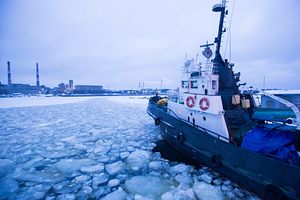The Rebalance authors Mercy Kuo and Angie Tang regularly engage subject-matter experts, policy practitioners and strategic thinkers across the globe for their diverse insights into the U.S. rebalance to Asia. This conversation with Dr. Øystein Tunsjø – Associate Professor at the Center for Asia Security Studies, Norwegian Institute for Defense Studies, and author and editor of multiple publications on East Asian security, China’s energy security policy, geopolitics, risk and hedging management, including Security and Profit in China’s Energy Policy: Hedging Against Risk, Twenty-First Century Seapower: Conflict and Cooperation at Sea and US-China-EU Relations: Managing a New World Order – is the 24th in “The Rebalance Insight Series.”
How is China positioning itself in the Arctic?
China has not published any official Arctic strategy, policy or white paper, which suggest that the region has not been a priority and presently not high enough on the political agenda in Beijing. Nonetheless, statements by Chinese officials and China’s membership as a permanent observer in the Arctic Council have clarified China’s position on Arctic affairs and acknowledged China’s interests in the region. China’s growing activism in the Arctic is primarily shaped by scientific and climate considerations, commercial interest in the petroleum, shipping and mineral sector, as well as diplomatic and legal concerns. China’s willingness to become an Arctic Council observer supports the view that China does not challenge the sovereignty of the littoral states in the Arctic Ocean and remains committed to respecting the rule of law, including UNCLOS. China is positioning itself, and gaining a “foot in the door,” in order to access and extract resources and take advantage of strategic, economic, military, and scientific opportunities in the Arctic region in the years ahead.
How does China’s Arctic strategy fit into its Maritime Silk Road initiative?
China’s objectives in the Arctic could complement the One Belt, One Road Strategy (OBOR). Geographically, the Indian Ocean and the Arctic Ocean are the southern and northern flanks of the Eurasian landmass. Investments in shipping and infrastructure along the Northern Sea Route and the Maritime Silk Road can enhance China’s Silk Road Economic Belt strategy. In addition, China remains a huge littoral state. Consequently, China can add three oceanic frontiers to Mackinder’s “heartland” in Eurasia and overcome some of the challenges in controlling the heartland envisioned in the past. This could provide China with a favorable geopolitical position and an opportunity to “command the world islands” – Asia, Europe and Africa – in the twenty first century. However, it remains to be seen if China can successfully implement the OBOR strategy and whether Chinese investments in the Arctic region can complement this strategy.
Compare and contrast the China-Russia energy security competition and cooperation dynamic in Central Asia with that in the Arctic.
China is a major petroleum consumer and Russia is a major petroleum producer. They are not competing directly. Sino-Russian energy cooperation is strongest in the Arctic were Russia is looking for investments. China and its national oil companies (NOCs) are now one of the few willing to invest in this high cost producing region. China’s oil companies are looking for experience in international project management and are aiming to advance their technological skills. The Chinese government is seeking to enhance China’s energy security through a hedging strategy that diversifies through investments in more costly petroleum sources and transportation routes.
Control over the future of Central Asian petroleum flows and production rights has emerged as a contentious issue between Russia and China. Traditionally, Russia has contractually locked up petroleum supplies from Central Asia and controlled a substantial part of the petroleum exports from Central Asia, which were shipped through the Russian pipeline system. As Kazakhstan and Turkmenistan have developed alternative pipeline routes to China for their petroleum exports, Russia faces stronger competition in securing cheap Central Asian petroleum.
What is the impact of China’s increasing influence in Central Asia vis-à-vis Russia?
Beijing’s growing influence in Central Asia undermines important Russian objectives, namely, to maintain and exploit its monopsony position vis-à-vis Central Asian suppliers and to obstruct efforts by Central Asian suppliers to bypass the Gazprom export pipeline system. However, in some cases China and Russia are not competing for the same reserves and their interests may be complementary. For example, the Kazakhstan-China crude pipeline has, at least temporarily, opened up an alternative route for the export of Russian crude oil to China.
Furthermore, the major Russian petroleum companies may dislike the strong competition from the Chinese NOCs for exploration, production, and market share in the Central Asian petroleum market, but it might be preferable for Gazprom that Central Asian gas moves to the East rather than through alternative routes to the West that might challenge Russia’s strong position in the European gas market.
With the United States as a member of the Arctic Council, what should the next U.S. president understand about China’s strategic interests in the Arctic?
The current stakes in the circumpolar Arctic region are not sufficiently high to warrant confrontation between the U.S. and China. Cooperation predominantly guides their policies and activities. While they play different roles and increasingly seek to demonstrate their influence, there are common interests, such as in the freedom of the seas, in resource extraction and in developing infrastructure in the region. So far, there are few developments suggesting that the Arctic will be a focal point of potential rivalry or confrontation in broader U.S.-China relations. Other areas are more central to their respective international priorities, and to their interaction.
Mercy A. Kuo is an advisory board member of CHINADebate and was previously director of the Southeast Asia Studies and Strategic Asia Programs at the National Bureau of Asian Research. Angie O. Tang is Senior Advisor of Asia Value Advisors, a leading venture philanthropy advisory firm based in Hong Kong.

































